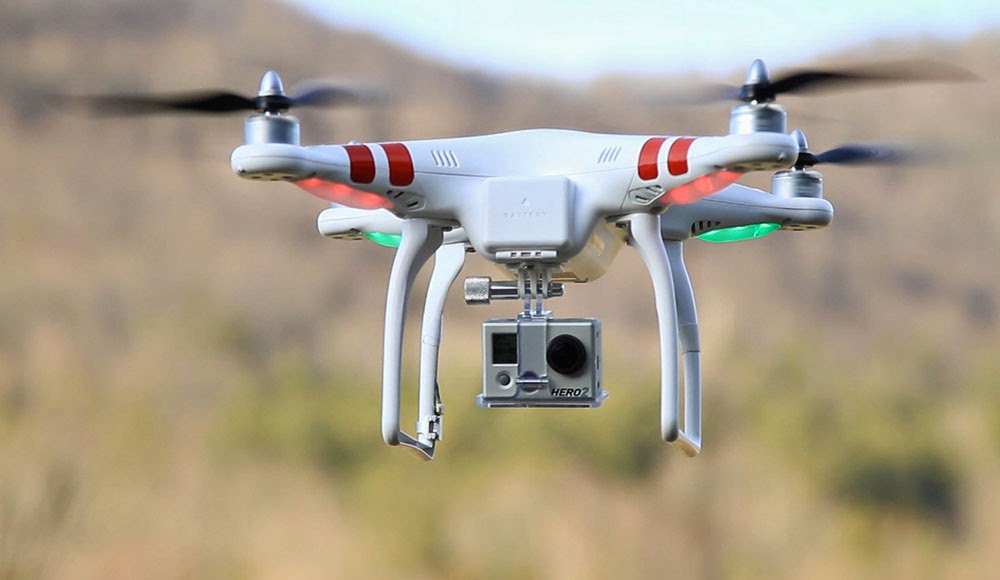 [Image: A drone from DJI].
[Image: A drone from DJI].
It’s hardly surprising to read that drones can be repurposed as burglars’ tools; at this point, take any activity, add a drone, and you, too, can have a news story (or Kickstarter) dedicated to the result.
“Why not send an inexpensive drone, snoop in your windows, see if you have any pets, see if you have any expensive electronics, maybe find out if you have any jewelry hanging around,” a security expert wonders aloud to Hawaii’s KITV, describing what he sees as the future of burglary. Burglars “can do all that with a drone without ever stepping a foot on your property line.”
“So what’s a homeowner to do?” the TV station asks.
They suggest following the drone back to its owner, who, due both to battery life and signal range, will be nearby; or even installing “new expensive high-tech drone detection systems that claim to detect the sounds of a drone’s propellers.” This is absurd—suggesting that some sort of drone alarm will go off at 3am, driving you out of bed—but it’s such a perfectly surreal vision of the suburbs of tomorrow.
Fortifying our homes against drone incursion will be the next bull market in security: whole subdivisions designed to thwart drone flights, marketed to potential homeowners specifically for that very reason.
You go home for the weekend to visit your parents where, rather than being enlisted to mow the lawn or clean the gutters, you’re sent you out on drone duty, installing perimeter defenses or some sort of jamming blanket, an electromagnetically-active geotextile disguised beneath the mulch. Complex nets and spiderweb-like antennas go on sale at Home Depot, perfect for snaring drone rotors and leading to an explosion in suburban bird deaths.
 [Image: A drone from DJI].
[Image: A drone from DJI].
This news comes simultaneously with a story in Forbes, where we read that drone manufacturer DJI is implementing a GPS block on its products: they will no longer be able to fly within 15.5 miles of the White House.
The company is issuing “a mandatory firmware update to all Phantom drones that will restrict flight within a 15.5 mile radius centered around downtown Washington D.C. Pilots looking to operate their Phantom drone will not be able to take off or fly within the no-fly-zone.”
Based off a drone’s GPS coordinates, the technology to geo-fence drones from entering a particular airspace, especially around major airports, has been around in Phantoms since early last year. The new update will add more airports to its no-fly-zone database as the 709 no-fly-zones already in the Phantom’s flight controller software will expand to more than 10,000, with additional restrictions added to prevent flight across national borders.
This is remarkable for a number of reasons, not the least of which is the fact that firmware updates and geography now work together to disable entire classes of products within a given zone or GPS range. Put another way, drones today—but what tomorrow?
Geofencing or “locationized” firearms have already been discussed as a possible future form of gun control, for example, and it would not be at all surprising to see “locationized” smartphones or geofenced cameras becoming a thing in the next few years.
All a government (or criminal syndicate) would have to do is release a (malicious) firmware update, temporarily shutting down certain types of electronics within range of, say, a presidential inauguration (or a bank heist).
 [Image: A drone from DJI].
[Image: A drone from DJI].
More to the point of this post, however, GPS-based geofencing will also become part of the electromagnetic armature of future residential developments, a new, invisible layer of security for those who are willing to pay for it.
Think, for example, of the extraordinary geographic dazzle effects used by government buildings to camouflage their real-world locations: as Dana Priest and William Arkin wrote for The Washington Post back in 2012, “most people don’t realize when they’re nearing the epicenter of Fort Meade’s, even when the GPS on their car dashboard suddenly begins giving incorrect directions, trapping the driver in a series of U-turns, because the government is jamming all nearby signals.”
If half the point of living in the suburbs is to obtain a certain level of privacy, personal safety, and peace of mind, then it is hardly science fiction to suggest that the electromagnetic fortification of suburbia is on the immediate horizon.
You won’t just turn on a burglar alarm with your handy smartphone app; you’ll also switch on signal-jamming networks hidden in the trees or a location-scrambling geofence camouflaged as a garden gnome at the edge of your well-mown lawn. Drones, dazzled by invisible waves of unpredictable geographic information, will perform U-turns or sudden dives, even racing off to a pre-ordained security cage where they can be pulled from the air and disabled.
The truly high-end residential developments of tomorrow will be electromagnetically fortified, impervious to drones, and, unless you’ve been invited there, impossible for your cars and cellphones even to find.
